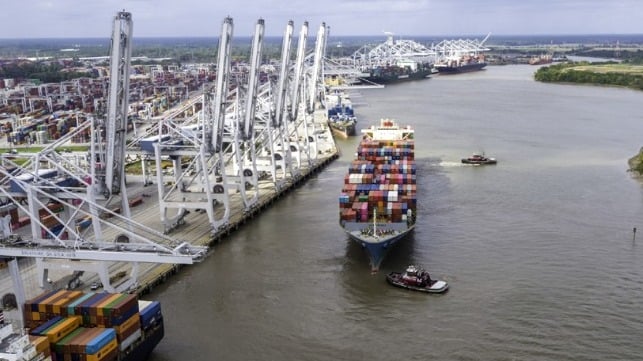Georgia Ports Authority Approves Projects for Capacity Expansion

The Georgia Ports Authority approved a series of capital improvement projects responding to the rapid growth in volumes at the ports in the past six months. The projects, which will build on ongoing efforts at the ports, will add more than 20 percent capacity both for the container operations and in Ro/Ro vehicle traffic.
“Right now, we are moving container volumes that we did not expect to see for another four years,” said GPA Executive Director Griff Lynch. “We are expediting capacity projects that will increase the speed and fluidity of cargo handling at the Port of Savannah.”
In its busiest February ever, the Port of Savannah moved 390,804 TEUs of cargo, an increase of 7.2 percent, or 26,400 TEUs compared to February 2020. Between September 2020 and February 2021, in total GPA handled 2.64 million TEUs, an increase of nearly 375,000, or 16.5 percent, compared to the same six-month period a year ago. Since the upswing in containerized cargo began last fall, GPA reports that it has seen significant growth in categories including machinery, appliances and electronics, hardware and houseware, food, furniture, apparel and textiles.
“In terms of cargo volumes, we’ve added the equivalent of an extra month of trade since September,” Lynch said.
To address the needs for added capacity both near- and longer-term, the port approved a series of projects, some of which were completed in February while others will be implemented over the next few months.
A terminal enhancement effort dubbed the Peak Capacity project will establish 2,100 new grounded container slots. The project will add 650,000 twenty-foot equivalent container units of annual container yard capacity in two phases, with the first opening in September.
The increased yard capacity is in addition to bringing expanded container operations online at Savannah’s Ocean Terminal in late February. This will add 250,000 TEUs of annual capacity at the Port of Savannah and also be important during the next phase of the project when Berth 1 at Garden City Terminal is straightened. The board approved the Berth 1 renovation that will increase berth capacity by an estimated 1 million TEUs per year by June 2023.
In other projects aimed at increasing Savannah’s big ship capability, the GPA Board approved last November the purchase of eight new ship-to-shore cranes. The new machines will replace six older models, bringing the total to 38 cranes. The eight taller cranes will arrive in 2023, allowing Garden City Terminal to serve more 15,000+ TEU vessels. Further adding to the cargo handling capacity, the board this week approved the purchase of 20 new rubber-tired gantry cranes. The new RTGs will be tall enough to stand over six containers, one higher than Savannah’s older RTGs.
The port infrastructure is also being enhanced in stages to support the capacity increases. By the end of this year, the deepening of Savannah’s harbor, a Corps of Engineers project, will be substantially completed providing greater scheduling flexibility for vessel transit.
At the near-by Ro/Ro port in Brunswick, Georgia, the port has also experienced a strong increase in volumes as the auto plants in the region reopened and increased production after delays related to the pandemic. In February, volume was up 23 percent handling 50,945 units of autos and heavy machinery. To support the growth of the Ro/Ro segment, the port authority received a permit from the U.S. Army Corps of Engineers to develop a fourth berth for Ro/Ro cargo in Brunswick. The project, currently in the engineering phase, will provide increased speed and flexibility in auto processing.
According to Georgia Ports, Savannah currently handles more than nine percent of the total U.S. containerized cargo volume. The projects that they are undertaking are designed to increase the port’s capacity beyond six million TEUs.
